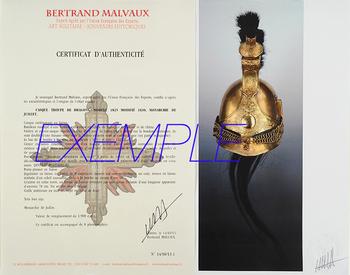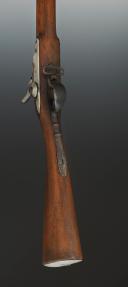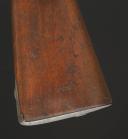
INFANTRY RIFLE, model 1822Tbis transformed into percussion, Restoration. 28030R
Sold out
INFANTRY RIFLE, model 1822Tbis transformed to percussion, Restoration period. 28030R
Five-sided breech then round barrel, numbered "2489", marked "C de 17.8", length 1.03 m, 1.082 m with breech tail. Walnut stock with long barrel inscribed on the stock with the name of the "MUTZIG" manufacture, numbered "2489" "167", and stamped "PDL" surmounted by a rooster (property of the state), stamp for the weapons of the National Guard under the July Monarchy (PDL: state property). All fittings in steel. Regulation lock transformed to percussion, pan cover in place. Engraved with the name of the "Royal Manufacturer of Maubeuge".
Total length of the weapon: 1.42 m.
France.
Restoration period.
Good condition, missing ramrod and counter-plate.
**PAYMENT INFORMATION:**
Firearms cannot be paid for via Paypal. This company refuses to engage in the trade of any type of weapons, including freely circulating and holding collector's firearms. Therefore, only checks, remote credit card payments (VPC), and IBAN transfers are accepted.
**Google Ranking Service Requested Warning:**
This firearm is an ancient collectible weapon that cannot be used, as it is inactive, and modern cartridges are not compatible with this non-functioning firearm.
The law of March 6, 2012, classifies firearms into 4 categories and regulates their acquisition and possession methods. Classification is crucial. Decree No. 2013-700 of July 30, 2013, specifies the list of weapons for each category. The presented firearm falls under category D2 with free possession, therefore it can be purchased without restrictions since it is inactive.
**NOTE:**
END OF A LEGEND "PDL" - THE SEAL ON NATIONAL GUARD WEAPONS
Extensive research has not led to any citation confirming the reality of the motto "Pour le droit" (For the law). So what is it? What is the National Guard? The National Guard was created during the Revolution as a militia tasked with maintaining order and law in troubled times. It consisted of all citizens aged 20 to 60, listed and classified for service, either in reserve or active guard. Initially, National Guards were predominantly bourgeois as they were required to equip themselves at their own expense, and to be part of the cavalry, one needed a horse. For the bourgeoisie, this role was a means of maintaining a form of power, of distinguishing themselves from the rest of the population. National Guards were dispersed throughout all municipalities, acting as "police" under the orders of a commander, the mayor, and the prefect. Under the Empire, the National Guard sometimes served as a reserve army, mobilized for Napoleon's wars as needed. After their dissolution by Charles X in 1827, it was reestablished by Louis Philippe in 1830, with a company formed in each municipality. Infantry, artillery, cavalry, and even firefighters were formed. The National Guard was reactivated to end unrest and maintain peace throughout France after the July Revolution.
Marking of PDL on weapons in 1831:
By the end of 1830, the Minister aimed to organize the National Guards and account for the weapons distributed during the July Revolution. A document from the Lyon city archives dated August 10, 1830, attests to this. In January 1831, a Ministerial circular decided to mark the weapons distributed by the Ministry of War, which belonged to the state. They were stamped with the "PDL" seal signifying "Property of the State", as indicated in a document from the prefecture to the Lyon archives on January 20, 1831.
This marking was done using a punch traveling from village to village in each canton. The seal was applied in the presence of the assembled National Guards by mayors and commanders. The punch remained the property of the canton's capital, allowing for future markings. A report was drawn up, signed by the Mayor, and sent to the prefecture.
The weaponry of the National Guards was highly diverse, including rifles, sabers, cartridge boxes, and other military-type equipment and uniforms, often privately manufactured and somewhat distinct from standard models. They were acquired by the Guards themselves or by municipalities. Additionally, there were standard issue weapons provided to municipalities by the Ministry of War.
Only the latter category of state-owned gear was to be marked to attest ownership and prevent weapon dispersion. An excerpt from the January 1831 circular reproduces the printed notice accompanying the municipal punches, detailing the method of marking rifles. The circular also mentions the creation, with the Interior Minister's approval, of an armament manual for the National Guards.
In 1848, following the February Revolution and the advent of the Second Republic, a decree reactivated the National Guard in March. The front page of the "Courrier de la Drôme et de l'Ardèche" from October 29, 1848, No. 224, indicates that the same measures as in 1831 (still in effect) were taken with the census of National Guards and their arms. The "PDL" marking of state-owned arms was reaffirmed. It was also noted that the private armory transformation of National Guard firearms was prohibited to prevent the proliferation of available calibers.
The "PLD" Stamp:
The metal imprint in the wood created by blackening the metal stamp with flame displays these three letters PDL. Historically interpreted as the motto "Pour Le Droit" (For the Law) without any foundation, these documents show that it simply indicates "Property of the State". This stamp can be found on the stocks of pistols and regulation rifles used in the National Guard, often the 1816 or 1822 troop model pistols and the 1777 corrected An IX rifles. The Ministry of War distributed obsolete weapons to the National Guards, reserving the newer models such as the 1822 T and Tbis for the military. These markings evolved over time.
Additionally, consultation of military archive records revealed further evolutions of this state identification mark.
The PDL Stamp on White Arms:
Observation of sabers or bayonets sometimes reveals this stamped marking.
Five-sided breech then round barrel, numbered "2489", marked "C de 17.8", length 1.03 m, 1.082 m with breech tail. Walnut stock with long barrel inscribed on the stock with the name of the "MUTZIG" manufacture, numbered "2489" "167", and stamped "PDL" surmounted by a rooster (property of the state), stamp for the weapons of the National Guard under the July Monarchy (PDL: state property). All fittings in steel. Regulation lock transformed to percussion, pan cover in place. Engraved with the name of the "Royal Manufacturer of Maubeuge".
Total length of the weapon: 1.42 m.
France.
Restoration period.
Good condition, missing ramrod and counter-plate.
**PAYMENT INFORMATION:**
Firearms cannot be paid for via Paypal. This company refuses to engage in the trade of any type of weapons, including freely circulating and holding collector's firearms. Therefore, only checks, remote credit card payments (VPC), and IBAN transfers are accepted.
**Google Ranking Service Requested Warning:**
This firearm is an ancient collectible weapon that cannot be used, as it is inactive, and modern cartridges are not compatible with this non-functioning firearm.
The law of March 6, 2012, classifies firearms into 4 categories and regulates their acquisition and possession methods. Classification is crucial. Decree No. 2013-700 of July 30, 2013, specifies the list of weapons for each category. The presented firearm falls under category D2 with free possession, therefore it can be purchased without restrictions since it is inactive.
**NOTE:**
END OF A LEGEND "PDL" - THE SEAL ON NATIONAL GUARD WEAPONS
Extensive research has not led to any citation confirming the reality of the motto "Pour le droit" (For the law). So what is it? What is the National Guard? The National Guard was created during the Revolution as a militia tasked with maintaining order and law in troubled times. It consisted of all citizens aged 20 to 60, listed and classified for service, either in reserve or active guard. Initially, National Guards were predominantly bourgeois as they were required to equip themselves at their own expense, and to be part of the cavalry, one needed a horse. For the bourgeoisie, this role was a means of maintaining a form of power, of distinguishing themselves from the rest of the population. National Guards were dispersed throughout all municipalities, acting as "police" under the orders of a commander, the mayor, and the prefect. Under the Empire, the National Guard sometimes served as a reserve army, mobilized for Napoleon's wars as needed. After their dissolution by Charles X in 1827, it was reestablished by Louis Philippe in 1830, with a company formed in each municipality. Infantry, artillery, cavalry, and even firefighters were formed. The National Guard was reactivated to end unrest and maintain peace throughout France after the July Revolution.
Marking of PDL on weapons in 1831:
By the end of 1830, the Minister aimed to organize the National Guards and account for the weapons distributed during the July Revolution. A document from the Lyon city archives dated August 10, 1830, attests to this. In January 1831, a Ministerial circular decided to mark the weapons distributed by the Ministry of War, which belonged to the state. They were stamped with the "PDL" seal signifying "Property of the State", as indicated in a document from the prefecture to the Lyon archives on January 20, 1831.
This marking was done using a punch traveling from village to village in each canton. The seal was applied in the presence of the assembled National Guards by mayors and commanders. The punch remained the property of the canton's capital, allowing for future markings. A report was drawn up, signed by the Mayor, and sent to the prefecture.
The weaponry of the National Guards was highly diverse, including rifles, sabers, cartridge boxes, and other military-type equipment and uniforms, often privately manufactured and somewhat distinct from standard models. They were acquired by the Guards themselves or by municipalities. Additionally, there were standard issue weapons provided to municipalities by the Ministry of War.
Only the latter category of state-owned gear was to be marked to attest ownership and prevent weapon dispersion. An excerpt from the January 1831 circular reproduces the printed notice accompanying the municipal punches, detailing the method of marking rifles. The circular also mentions the creation, with the Interior Minister's approval, of an armament manual for the National Guards.
In 1848, following the February Revolution and the advent of the Second Republic, a decree reactivated the National Guard in March. The front page of the "Courrier de la Drôme et de l'Ardèche" from October 29, 1848, No. 224, indicates that the same measures as in 1831 (still in effect) were taken with the census of National Guards and their arms. The "PDL" marking of state-owned arms was reaffirmed. It was also noted that the private armory transformation of National Guard firearms was prohibited to prevent the proliferation of available calibers.
The "PLD" Stamp:
The metal imprint in the wood created by blackening the metal stamp with flame displays these three letters PDL. Historically interpreted as the motto "Pour Le Droit" (For the Law) without any foundation, these documents show that it simply indicates "Property of the State". This stamp can be found on the stocks of pistols and regulation rifles used in the National Guard, often the 1816 or 1822 troop model pistols and the 1777 corrected An IX rifles. The Ministry of War distributed obsolete weapons to the National Guards, reserving the newer models such as the 1822 T and Tbis for the military. These markings evolved over time.
Additionally, consultation of military archive records revealed further evolutions of this state identification mark.
The PDL Stamp on White Arms:
Observation of sabers or bayonets sometimes reveals this stamped marking.
Reference :
28030R

Next update Friday, april 4th at 1:30 PM
FOR ALL PURCHASES, PAYMENT IN MULTIPLE CHECKS POSSIBLE
bertrand.malvaux@wanadoo.fr 06 07 75 74 63
An authenticity certificate of the item including the description published on the site, the period, the sale price, accompanied by one or more color photographs is automatically provided for any item priced over 130 euros. Below this price, each certificate is charged 5 euros.
Only items sold by me are subject to an authenticity certificate, I do not provide any expert reports for items sold by third parties (colleagues or collectors).









